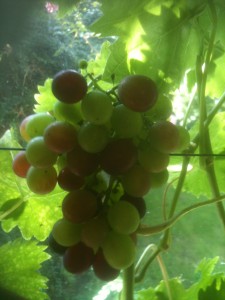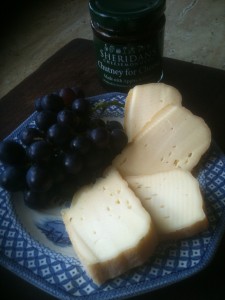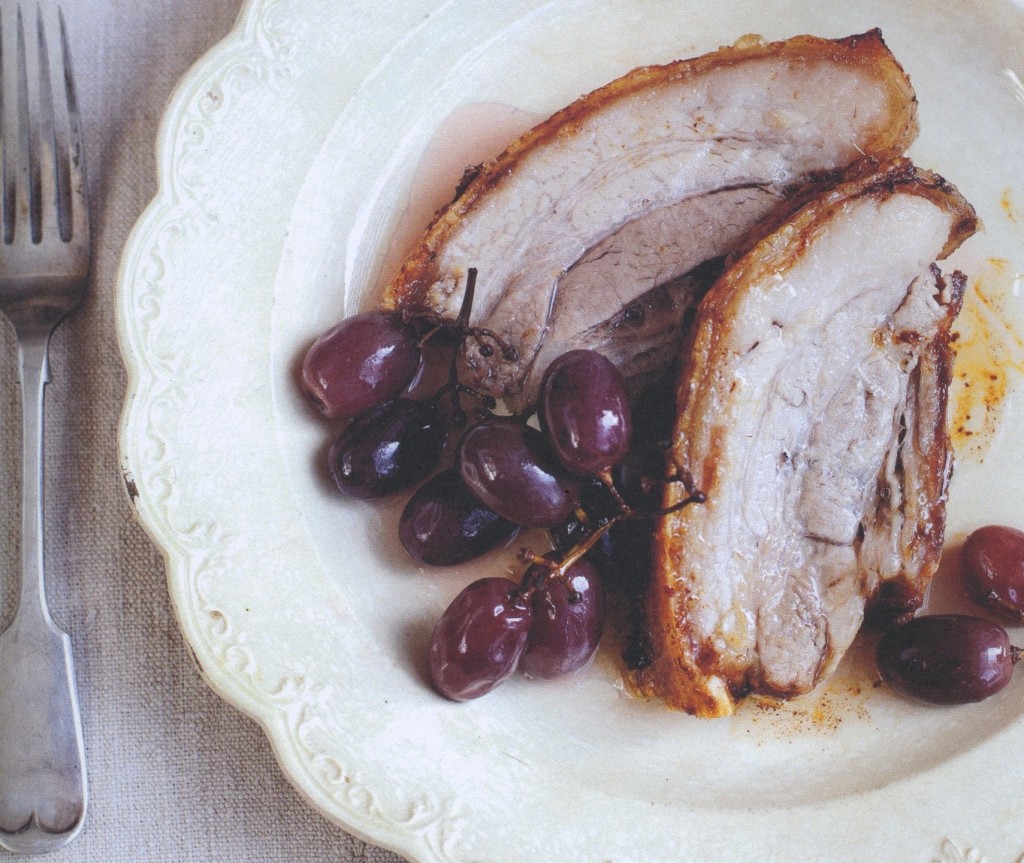 Well it may have been a disappointing year in the garden, but our grapevine has come good at last – just when we’d about given up on it.
Well it may have been a disappointing year in the garden, but our grapevine has come good at last – just when we’d about given up on it.
It’s a Black Hamburg, well known as ‘the easiest grape to grow’, yet I’ve lost count of the number of dark winter days I’ve spent trying to get the pruning right, with the RHS pruning book in one hand and the pretty V&A secateurs in the other (the plain red Felco ones are kept for more serious work), but all to no avail. Until this year. The pruning book went missing and I had to wing it: et voilà, la vendange! Or something like that. I don’t think we’ll be making our own wine any time soon but, while I’m embarrassed to admit how long I’ve been missing the point of pruning vines, it’s been a consolation to remember that the late great Michael O’Callaghan – whose refreshing light white wines at Longueville were such a delight – once told me that he got it wrong for years too.
Anyway, there we were this year, with plenty of flowers fattening up into promising bunches and a few doses of tomato feed and several record breakingly sunless months later, we have a crop. Everybody seemed very suspicious of it for some reason though. I noticed a strange reluctance to taste a test grape, never mind take down a bunch or two. Even when offered to departing visitors to take home, they’d just say ‘maybe in a week or two’. Ho hum. I’m not sure what they were all so suspicious of, but even I was a bit worried they could be disappointing as I’d noticed comments in the gardening press about the wet summer and ‘flavourless, watery grapes’…
 So, afraid that our little treasures would end up like so much of the food that’s grown in gardens and allotments – unused – I just snipped a bunch off one day, gave it a rinse and put it out with bite of Gubbeen and brown bread for lunch, not a word said. It was the pips that were the giveaway, though. The grapes sold in shops are usually seedless these days, so it was obvious something was up. But all was well. Surprisingly well in fact. Although smaller than most commercial varieties, they have really good flavour and we’re enjoying them mightily. It seems a shame to pick them all as the bunches look so handsome, but needs must and the amount produced this year is quite modest, so they’re still a treat and we’re as proud as punch with them.
So, afraid that our little treasures would end up like so much of the food that’s grown in gardens and allotments – unused – I just snipped a bunch off one day, gave it a rinse and put it out with bite of Gubbeen and brown bread for lunch, not a word said. It was the pips that were the giveaway, though. The grapes sold in shops are usually seedless these days, so it was obvious something was up. But all was well. Surprisingly well in fact. Although smaller than most commercial varieties, they have really good flavour and we’re enjoying them mightily. It seems a shame to pick them all as the bunches look so handsome, but needs must and the amount produced this year is quite modest, so they’re still a treat and we’re as proud as punch with them.
But Black Hamburg is a heavy cropper and, now that the pruning makes more sense, we could end up with a much bigger crop next year and wonder what to do with them. Maybe we could dry them to make raisins? Maybe. Or maybe we could try pickling them, using this recipe from Diana Henry’s new book ‘salt sugar smoke’. She specifies seedless grapes, but I’m happy to compromise on that.
“I started off making a sour version of these that I’d read about in Middle Eastern books, but with my sweet tooth (and that British love of the sweet with the savoury), I ended up doing them like this. You can alter the spices (star anise, cinnamon and ginger are all good). At first the grapes just wrinkle slightly in the syrup but the longer you keep them, the more they shrink. I actually like them best after about a week.”
SPICED BLACK PICKLED GRAPES
Fills 1 x 1 litre (1¾ pint) jar
550g (1lb 4oz) seedless black grapes
500g (1lb 2oz) granulated sugar
500ml (18fl oz) white wine or cider vinegar
10 black peppercorns
10 juniper berries, bruised
1 small dried chilli (optional)
½ cinnamon stick
FRAGRANT WHITE PICKLED GRAPES
Fills 1 x1 litre (1¾ pint) jar
550g (1lb 4oz) grapes, muscat if you can get them
300g (l0½ oz) granulated sugar
250 ml (9 fl oz) white wine vinegar
350ml (12fl oz) riesling
1 bay leaf
10 white peppercorns
In either case, pull sprigs of the grapes off the main stem. Put everything else into a saucepan and bring to a boil, stirring to help the sugar dissolve. Boil for about four minutes, then cool completely.
Wash and dry the grapes and put them into a warm sterilized jar. Pour over the vinegar and seal with a vinegar-proof lid. You can eat these immediately. The longer they are in the vinegar the more ‘pickled’ the grapes will taste and the more wrinkled they become. They will keep for a year.
How to use These are made for roast, pork – belly or loin – and look fabulous in little branches served alongside slices of the sweet, fatty meat. But they are also very lovely with patés (and a smooth chicken liver parfait), terrines and most cheeses.










